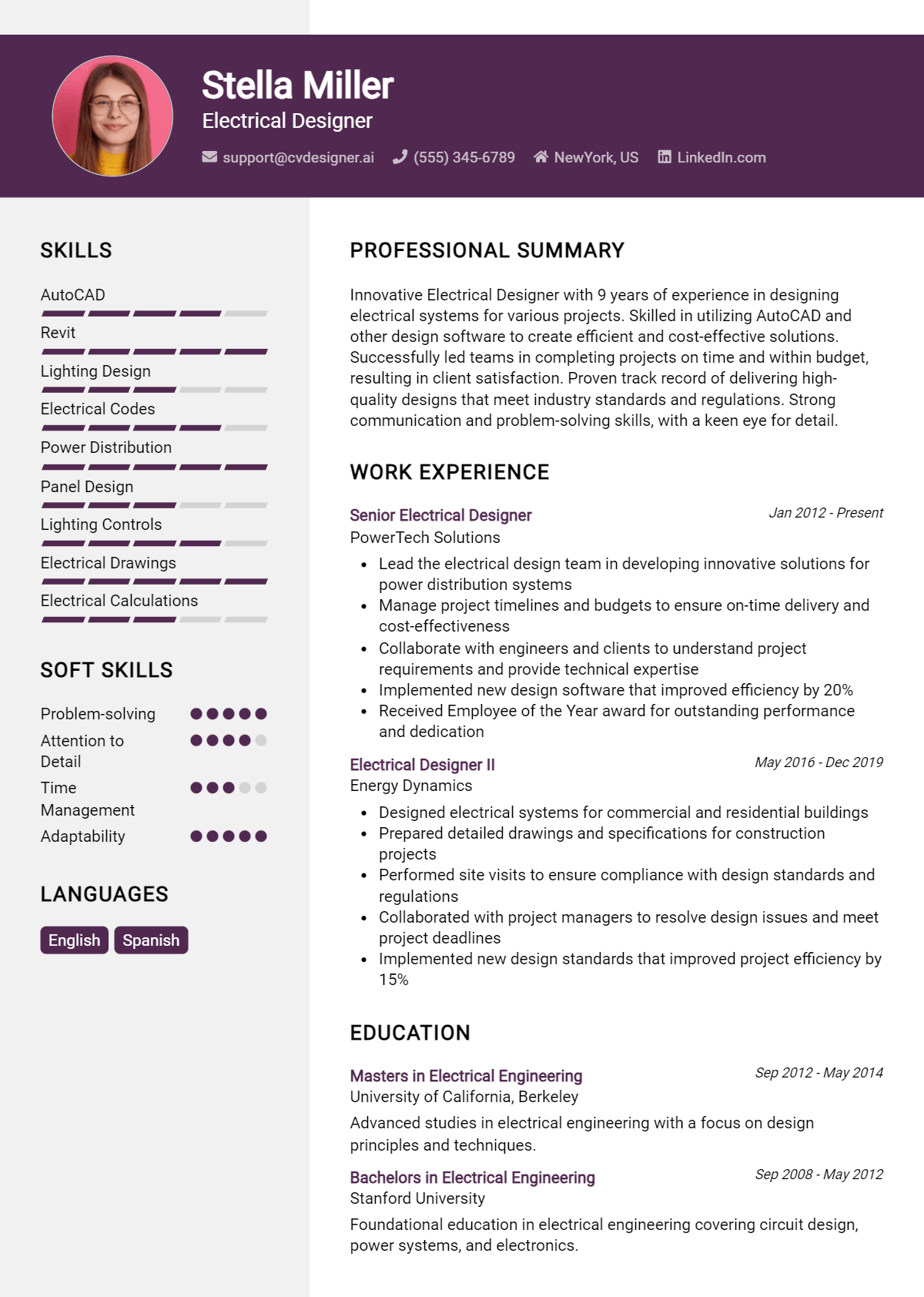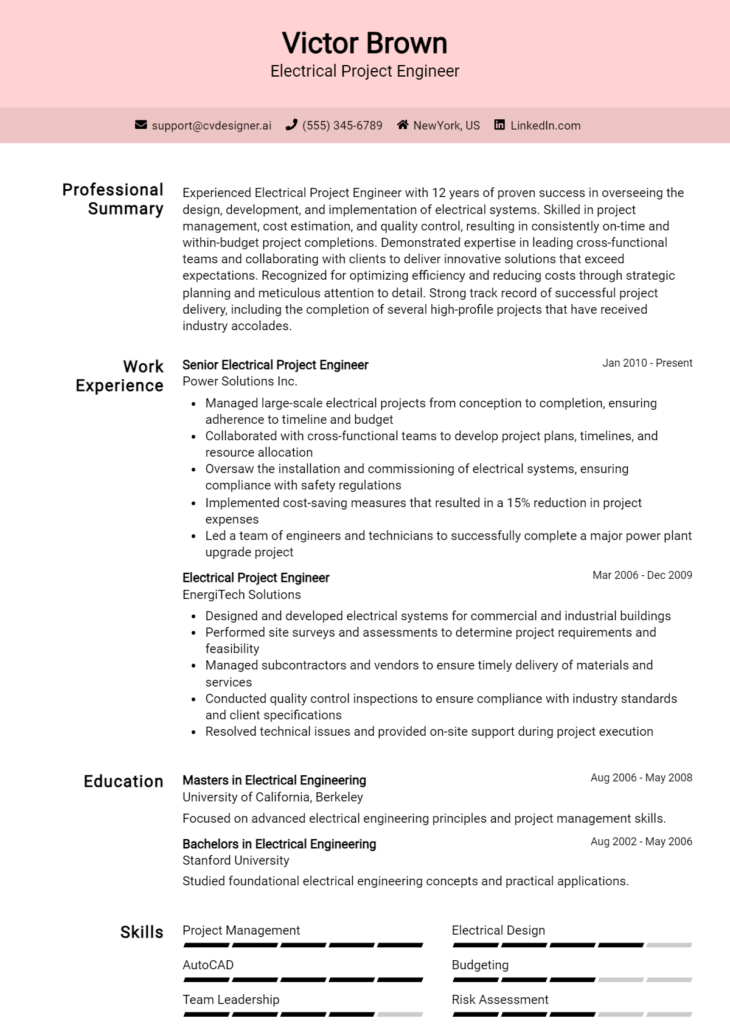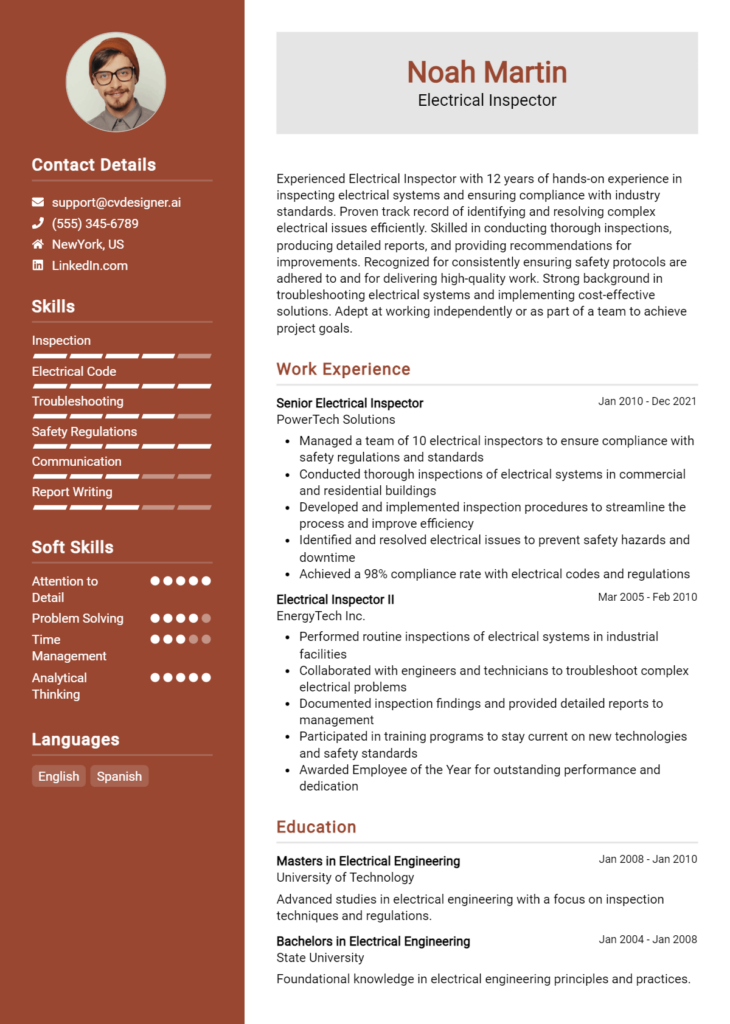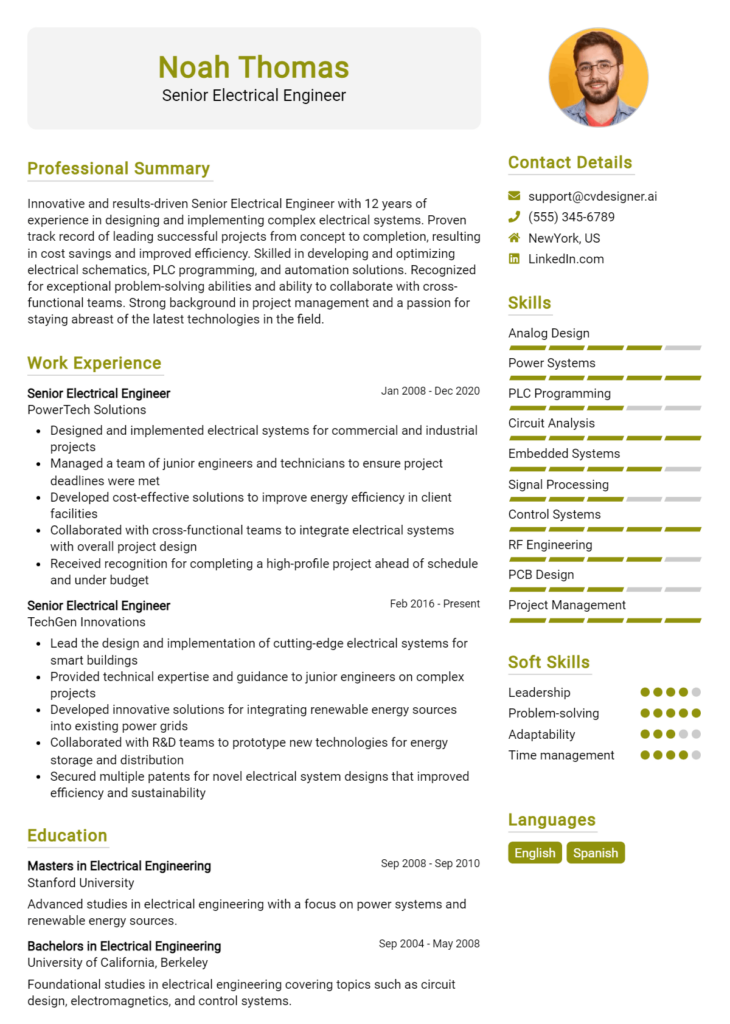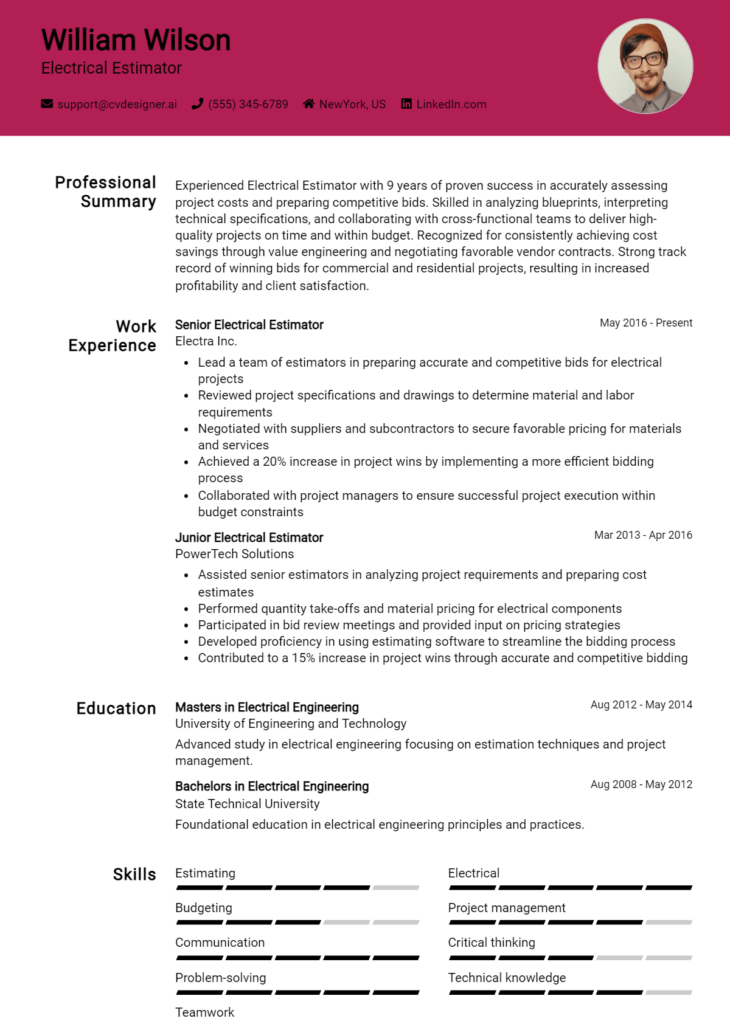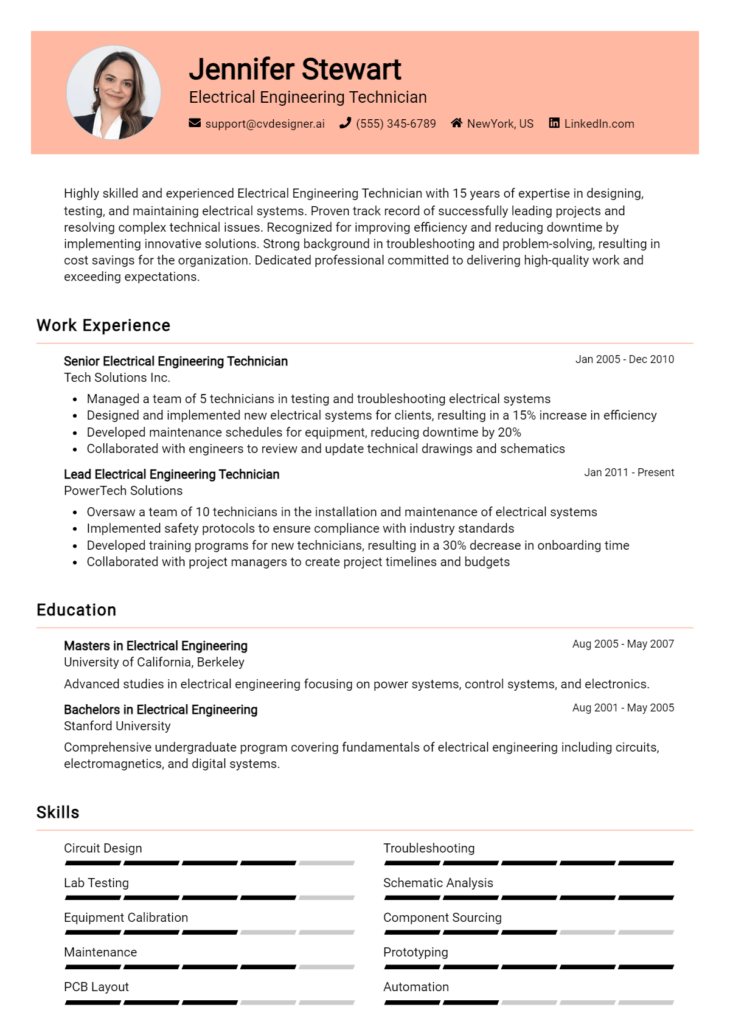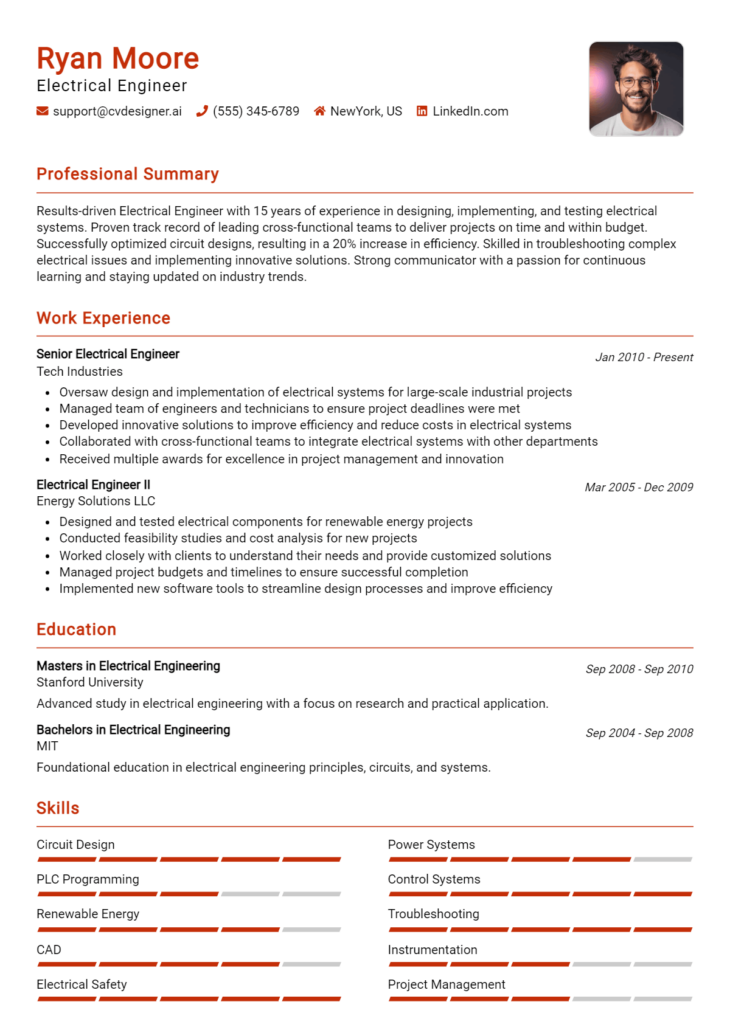Most Popular Electrical Designer Resume Examples
Explore additional Electrical Designer resume samples and guides and see what works for your level of experience or role.
As an Electrical Designer, you play a pivotal role in shaping the future of electrical systems across various industries. Your expertise not only ensures the functionality and safety of electrical designs but also contributes significantly to project efficiency and innovation. In a competitive job market, a well-crafted resume is your best tool to showcase your skills, experience, and unique contributions to potential employers. A standout resume can capture attention, highlight your qualifications, and ultimately open doors to exciting career opportunities.
In this comprehensive guide, we'll delve into the essential elements of crafting an effective Electrical Designer resume. Key topics will include an in-depth look at the responsibilities and skills that define the role, the best resume formats to employ for maximum impact, and common pitfalls to avoid when writing your resume. Additionally, we will provide resume examples tailored for various experience levels, along with expert tips on resume writing to enhance your presentation. Lastly, you'll learn how to select the right resume templates that align with your professional style and aspirations. Whether you’re just starting your career or looking to advance, this guide will equip you with the tools you need for success.
Key Responsibilities and Skills for a Electrical Designer
As an Electrical Designer, key responsibilities revolve around the design, development, and implementation of electrical systems and components. This role involves collaborating with engineers, architects, and project managers to ensure that electrical designs meet the required specifications and standards. Responsibilities may include:
- Creating detailed electrical schematics and layouts using CAD software
- Conducting electrical load calculations and feasibility studies
- Ensuring compliance with local, state, and federal electrical codes and safety standards
- Participating in project meetings and providing technical support during the construction phase
- Reviewing and approving shop drawings and submittals
- Performing site visits for inspections and troubleshooting
- Assisting in the development of project documentation and reports
Essential skills for an Electrical Designer include:
- Proficiency in CAD software and electrical design tools
- Strong understanding of electrical systems and components
- Excellent problem-solving and analytical skills
- Ability to work collaboratively in a team environment
- Knowledge of industry standards and regulations
- Attention to detail and accuracy in design work
- Effective communication skills, both verbal and written
Highlighting these skills effectively in the resume skills section is crucial, as it directly aligns your qualifications with the job requirements. Tailoring these responsibilities and skills to the specific job description enhances your chances of standing out to potential employers. Furthermore, consider how these skills can be showcased in your CV to create a compelling narrative that reflects your expertise and suitability for the Electrical Designer role.
Best Resume Format and Structure for a Electrical Designer
When crafting a resume for the role of an Electrical Designer, it’s important to choose a format that presents your qualifications clearly and professionally. Here’s a detailed guide on the best resume format and structure, including key sections to include:
Contact Information
Begin your resume with your contact details at the top. This section should include:
- Full Name
- Phone Number
- Email Address
- LinkedIn Profile (optional)
- Location (City, State)
Professional Summary
A concise professional summary should follow your contact information. This section should highlight your experience, skills, and what you bring to the table as an Electrical Designer. Aim for 2-4 sentences that showcase your expertise and key achievements. Tailor this summary to fit the job you're applying for, mentioning specific skills that align with the job description.
Work Experience
In this section, list your relevant work experience in reverse chronological order. Each entry should include:
- Job Title
- Company Name
- Location (City, State)
- Dates of Employment (Month, Year)
- Bullet points detailing your responsibilities and achievements. Use action verbs and quantify your accomplishments when possible (e.g., "Designed electrical systems for 15+ commercial buildings, improving energy efficiency by 20%").
Education
Include your educational background next. List your most recent degree first and include:
- Degree Earned (e.g., Bachelor of Science in Electrical Engineering)
- University Name
- Graduation Date (Month, Year)
- Relevant coursework or honors (if applicable)
Skills
This section should feature both hard and soft skills pertinent to the Electrical Designer role. Examples include:
- Proficiency in software (e.g., AutoCAD, Revit, MATLAB)
- Knowledge of electrical codes and standards
- Project management skills
- Communication and teamwork abilities
Certifications
List any relevant certifications that enhance your qualifications. This might include:
- Professional Engineer (PE) License
- Electrical Design Certification
- Any software-specific certifications (e.g., AutoCAD Certified Professional)
Tips for Resume Content
- Customize: Tailor your resume for each job application by incorporating keywords from the job description.
- Keep it concise: Aim for a one-page resume unless you have extensive experience.
- Use a clean layout: Choose a professional font and format that enhances readability, with clear headings and adequate white space.
- Proofread: Ensure there are no grammatical or typographical errors—these can detract from your professionalism.
Complementing Cover Letter Format
The resume format you choose should align with your cover letter format to create a cohesive application package. Use the same font and header style for both documents. In your cover letter, expand on the experiences listed in your resume, providing context and explaining how your skills make you an ideal candidate for the Electrical Designer position. This consistency reinforces your professionalism and attention to detail, making a strong overall impression on potential employers.
Writing Tips and Best Practices for a Electrical Designer Resume
When crafting a resume as an Electrical Designer, it’s essential to present your skills and experiences in a clear and impactful manner. Start by tailoring your resume to highlight your technical expertise and relevant projects, ensuring it aligns with the specific requirements of the job you're applying for. Utilizing resume writing tips can help achieve a polished and professional appearance, making your resume stand out to potential employers. Remember, the same attention to detail should apply when drafting your cover letter, as both documents collectively represent your professional narrative.
- Use action verbs to begin bullet points, such as "Designed," "Developed," "Implemented," and "Analyzed," to convey your contributions effectively.
- Quantify your achievements wherever possible (e.g., "Reduced energy consumption by 20% through innovative circuit design") to demonstrate the impact of your work.
- Incorporate industry-specific keywords related to electrical design, such as "AutoCAD," "schematics," "power distribution," and "compliance standards," to pass Applicant Tracking Systems (ATS) and catch hiring managers' attention.
- Keep your resume concise, ideally one page, focusing on the most relevant experiences and skills to the job you are applying for.
- Use a clean, professional layout with consistent formatting, including font size and style, to enhance readability.
- Highlight any certifications or licenses relevant to electrical design, such as Professional Engineer (PE) or Certified Electrical Designer (CED), to bolster your qualifications.
- Tailor your resume for each application by reflecting the specific skills or experiences that align with the job description to demonstrate your fit for the role.
- Proofread your resume multiple times to eliminate any errors, as attention to detail is crucial in the engineering field.
Common Mistakes to Avoid in a Electrical Designer Resume
Crafting a compelling resume as an Electrical Designer is crucial for making a strong impression on potential employers. However, many candidates fall into common traps that can undermine their chances of landing an interview. To stand out in a competitive job market, it's essential to avoid these pitfalls and present your skills and experience effectively. Here are some common mistakes to avoid when writing your Electrical Designer resume:
- Overloading the resume with excessive information, making it cluttered and hard to read.
- Using generic job descriptions that do not highlight specific skills or accomplishments.
- Failing to tailor the resume to the job description, missing opportunities to showcase relevant experience.
- Ignoring formatting consistency, which can create a disorganized appearance.
- Listing job duties instead of emphasizing achievements and measurable impacts.
- Including irrelevant work experience that does not pertain to the electrical design field.
- Neglecting to proofread for spelling and grammatical errors, which can damage professionalism.
- Using a one-size-fits-all approach without considering industry-specific keywords and jargon.
- Omitting important technical skills or certifications that are relevant to the position.
- Not including a clear contact information section, making it difficult for employers to reach you.
To further enhance your application, consider reviewing the common mistakes to avoid in a resume and ensure your cover letter is equally polished by avoiding common cover letter mistakes. By taking the time to refine both documents, you increase your chances of making a lasting impression on hiring managers.
Sample Electrical Designer Resumes
As the demand for skilled electrical designers continues to rise, creating a standout resume is essential for landing your desired position. Below are three sample resumes tailored for different experience levels and career paths in the electrical design field. Whether you are an experienced professional, an entry-level candidate, or someone looking to transition into this field, these examples can serve as a guide. For additional inspiration, explore more resume templates and consider pairing your resume with corresponding cover letter examples to create a complete job application package.
Experienced Electrical Designer Resume
John Doe
1234 Elm St, Anytown, ST 12345
(555) 123-4567
john.doe@email.com
Professional Summary
Detail-oriented electrical designer with over 8 years of experience in designing, developing, and testing electrical systems for commercial and industrial projects. Proven ability to collaborate with engineers and project managers to deliver high-quality designs that meet client specifications and comply with industry standards.
Experience
Senior Electrical Designer
XYZ Engineering, Anytown, ST
June 2018 - Present
- Led the electrical design for multiple high-profile projects, including a $5 million commercial building and a $2 million industrial facility.
- Developed detailed electrical schematics and layout plans using AutoCAD and Revit.
- Conducted site inspections to ensure compliance with designs and safety regulations.
- Collaborated with cross-functional teams to solve design challenges and improve project efficiency.
Electrical Designer
ABC Corp, Anytown, ST
March 2015 - May 2018
- Created electrical design documentation, including wiring diagrams and load calculations for various projects.
- Assisted in the selection of electrical equipment and components in line with project requirements.
- Participated in client meetings to present design options and gather feedback.
Education
Bachelor of Science in Electrical Engineering
State University, Anytown, ST
Graduated May 2014
Skills
- Proficient in AutoCAD, Revit, and ETAP
- Strong knowledge of electrical codes and standards
- Excellent problem-solving and analytical skills
- Effective communication and teamwork abilities
Entry-Level Electrical Designer Resume
Jane Smith
5678 Oak St, Othertown, ST 54321
(555) 987-6543
jane.smith@email.com
Professional Summary
Enthusiastic electrical engineering graduate with a strong foundation in electrical design principles and hands-on experience through internships. Eager to apply technical skills in a dynamic team environment to contribute to innovative electrical design projects.
Experience
Electrical Design Intern
Tech Solutions, Othertown, ST
June 2022 - August 2022
- Assisted senior designers in creating electrical layouts and schematics for residential projects.
- Gained experience using AutoCAD and Revit for drafting and design purposes.
- Supported the testing and troubleshooting of electrical systems and components.
Internship in Electrical Engineering
University Engineering Lab, Othertown, ST
September 2021 - May 2022
- Conducted experiments and simulations related to electrical circuits and systems.
- Collaborated with peers on projects that involved designing and prototyping electrical systems.
Education
Bachelor of Science in Electrical Engineering
Othertown University, Othertown, ST
Graduated May 2022
Skills
- Proficient in AutoCAD and MATLAB
- Strong understanding of electrical theory and principles
- Excellent communication and teamwork skills
- Detail-oriented and quick learner
Career Changer Electrical Designer Resume
Michael Johnson
9101 Pine St, Newtown, ST 67890
(555) 246-1357
michael.johnson@email.com
Professional Summary
Motivated professional with a background in mechanical design and a recent certification in electrical design seeking to leverage transferable skills and passion for electrical systems. Committed to delivering innovative design solutions and contributing to team success.
Experience
Mechanical Designer
Innovative Designs, Newtown, ST
January 2015 - July 2023
- Designed mechanical systems and components for various projects, ensuring adherence to industry standards.
- Collaborated with electrical teams to integrate electrical and mechanical designs effectively.
- Utilized CAD software to create detailed design documentation and specifications.
Certification in Electrical Design
Newtown Technical Institute, Newtown, ST
Completed June 2023
- Gained knowledge in electrical design principles, circuit design, and system integration.
Education
Bachelor of Science in Mechanical Engineering
Newtown University, Newtown, ST
Graduated December 2014
Skills
- Proficient in CAD software (AutoCAD, SolidWorks)
- Strong analytical and problem-solving skills
- Knowledge of electrical systems and design practices
- Adaptable and willing to learn new technologies
These sample resumes provide a solid foundation for creating your own. Remember to tailor your resume to reflect your unique experiences and qualifications. Happy job hunting!
Checklist for a Electrical Designer Resume
- Proofread for Typos and Errors: Carefully read your resume multiple times to catch any spelling, grammar, or punctuation mistakes. Consider using tools like Grammarly for additional support.
- Check Formatting Consistency: Ensure that font styles, sizes, and bullet points are consistent throughout the document. This creates a professional appearance.
- Tailor Content to the Job Description: Customize your resume to align with the specific requirements and keywords mentioned in the job posting. Highlight relevant skills and experiences that make you a strong candidate.
- Use Action Verbs: Start bullet points with strong action verbs (e.g., designed, implemented, analyzed) to convey your accomplishments and responsibilities effectively.
- Quantify Achievements: Where possible, include numbers or percentages to showcase your impact in previous roles (e.g., "Reduced project costs by 15% through efficient design practices").
- Include Relevant Certifications and Training: Make sure to list any relevant certifications, licenses, or training that pertain to electrical design, such as AutoCAD or other specialized software.
- Keep it Concise: Limit your resume to one or two pages, focusing only on the most relevant information. Avoid including unnecessary details that do not support your application.
- Use Professional Language: Maintain a formal tone and avoid jargon that may not be understood by all readers. Ensure your language is clear and professional.
- Consider an AI Resume Builder: Use an AI resume builder to make sure all elements are well-organized and formatted correctly.
- Replicate for Other Documents: Remember that a similar checklist can be followed for creating a CV or cover letter.
Key Takeaways for a Electrical Designer Resume Guide
In conclusion, crafting a compelling Electrical Designer resume is essential to stand out in a competitive job market. By utilizing the examples and tips provided in this guide, you can effectively showcase your technical skills, project experience, and creative problem-solving abilities. Remember, a well-structured resume not only highlights your qualifications but also reflects your professionalism. To take the next step, consider downloading a resume template from resume templates or a tailored cover letter from cover letter templates. For a more personalized touch, you can utilize our best resume maker to create a polished document that truly represents you. Additionally, following similar guidelines will be beneficial when crafting a compelling CV and an impactful cover letter. Take action today to elevate your job application and secure the position you desire!
